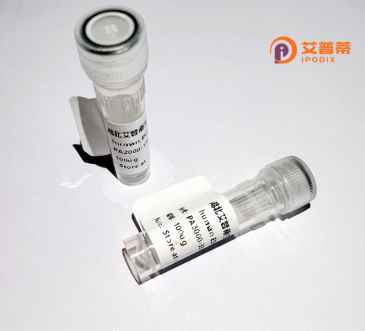
| 纯度 | >90%SDS-PAGE. |
| 种属 | Human |
| 靶点 | AGPAT5 |
| Uniprot No | Q9NUQ2 |
| 内毒素 | < 0.01EU/μg |
| 表达宿主 | E.coli |
| 表达区间 | 1-364aa |
| 氨基酸序列 | MLLSLVLHTYSMRYLLPSVVLLGTAPTYVLAWGVWRLLSAFLPARFYQALDDRLYCVYQSMVLFFFENYTGVQILLYGDLPKNKENIIYLANHQSTVDWIVADILAIRQNALGHVRYVLKEGLKWLPLYGCYFAQHGGIYVKRSAKFNEKEMRNKLQSYVDAGTPMYLVIFPEGTRYNPEQTKVLSASQAFAAQRGLAVLKHVLTPRIKATHVAFDCMKNYLDAIYDVTVVYEGKDDGGQRRESPTMTEFLCKECPKIHIHIDRIDKKDVPEEQEHMRRWLHERFEIKDKMLIEFYESPDPERRKRFPGKSVNSKLSIKKTLPSMLILSGLTAGMLMTDAGRKLYVNTWIYGTLLGCLWVTIKA |
| 分子量 | 68.5 kDa |
| 蛋白标签 | GST-tag at N-terminal. |
| 缓冲液 | 冻干粉 |
| 稳定性 & 储存条件 | Lyophilized protein should be stored at ≤ -20°C, stable for one year after receipt. Reconstituted protein solution can be stored at 2-8°C for 2-7 days. Aliquots of reconstituted samples are stable at ≤ -20°C for 3 months. |
| 复溶 | Always centrifuge tubes before opening.Do not mix by vortex or pipetting. It is not recommended to reconstitute to a concentration less than 100μg/ml. Dissolve the lyophilized protein in distilled water. Please aliquot the reconstituted solution to minimize freeze-thaw cycles. |
1. **《AGPAT5在脂肪代谢中的功能及其调控机制》** - 作者:李明等
摘要:研究揭示AGPAT5通过催化溶血磷脂酸生成磷脂酸,参与甘油三酯和磷脂合成,其表达水平受胰岛素信号通路调控,与肥胖相关代谢紊乱有关。
2. **《AGPAT5的结构解析与底物特异性研究》** - 作者:Chen X, Patel S
摘要:通过晶体结构分析阐明了AGPAT5的活性位点特征,发现其对长链酰基辅酶A具有特异性偏好,为设计靶向脂代谢疾病的抑制剂提供依据。
3. **《AGPAT5在肿瘤细胞脂质重塑中的作用》** - 作者:Wang Y et al.
摘要:AGPAT5在多种癌细胞中高表达,其沉默导致细胞内磷脂组成改变,抑制增殖和迁移,提示其可能通过脂膜合成影响肿瘤进展。
4. **《CRISPR/Cas9敲除AGPAT5对线粒体功能的影响》** - 作者:Liu R, Zhang H
摘要:实验表明AGPAT5缺失导致线粒体膜磷脂减少,氧化磷酸化能力下降,证实其在维持线粒体结构和能量代谢中的关键作用。
**Background of Recombinant Human Acyltransferase 1-Acylglycerol-3-Phosphate O-Acyltransferase Epsilon (AGPAT5)**
AGPAT5. a member of the 1-acylglycerol-3-phosphate O-acyltransferase (AGPAT) family, is an enzyme critical for phospholipid and triacylglycerol biosynthesis. It catalyzes the acylation of lysophosphatidic acid (LPA) to phosphatidic acid (PA), a key intermediate in lipid metabolism. This reaction occurs in the endoplasmic reticulum and mitochondria, contributing to membrane structure, lipid signaling, and energy storage.
AGPAT5 exhibits tissue-specific expression, with higher levels observed in metabolically active tissues like the liver, adipose, and brain. Unlike other AGPAT isoforms (e.g., AGPAT1-4), AGPAT5 has unique substrate preferences, favoring polyunsaturated fatty acids, which may influence membrane fluidity and specialized lipid signaling pathways. Dysregulation of AGPAT5 is linked to metabolic disorders, including lipodystrophy and insulin resistance, and has been implicated in cancer progression due to altered lipid dynamics promoting tumor cell survival.
The recombinant form of AGPAT5 is engineered for biochemical studies, enabling exploration of its enzymatic mechanisms, structural features, and interactions with lipid substrates. Such research aids in understanding its physiological roles and potential as a therapeutic target. Recent advances in recombinant protein technology have facilitated high-yield production of active AGPAT5. supporting drug discovery efforts aimed at modulating lipid metabolism in diseases.
×